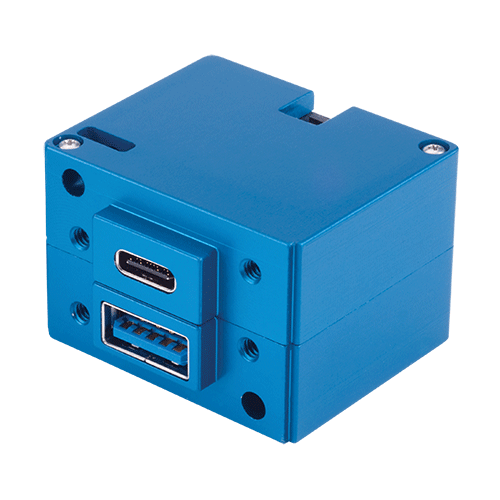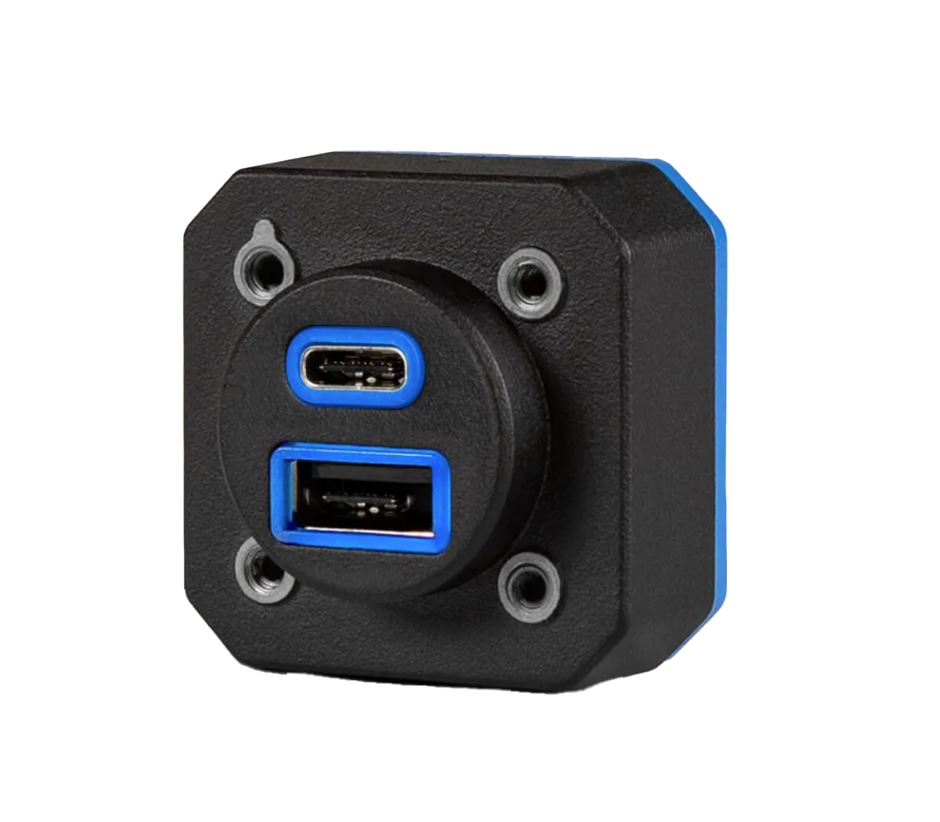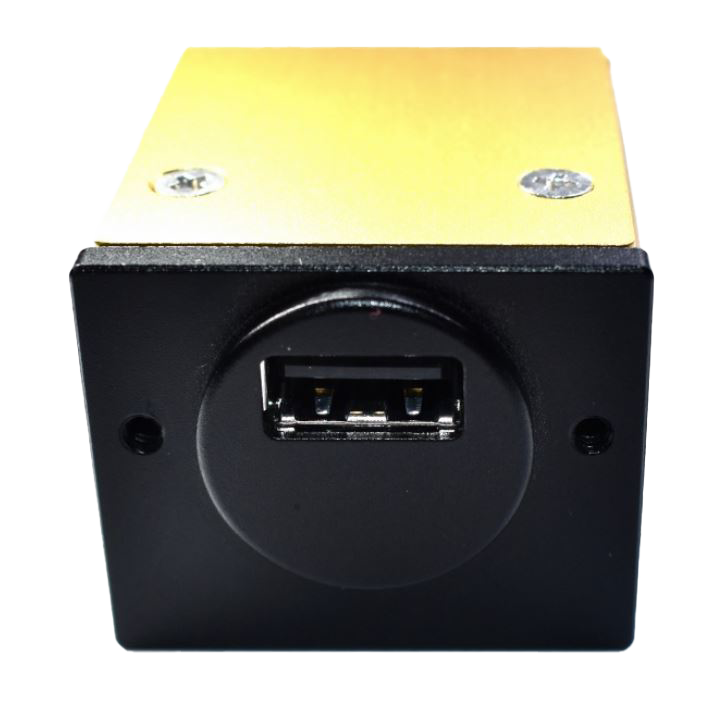Hand-held electronic devices are a constant part of our lives. Pilots, crew members, and passengers may all use devices for various reasons during flight, necessitating capabilities for charging devices onboard the aircraft. Multiple aircraft USB chargers are available on the market, but which one is the right choice for your aircraft, operation, and traveler needs?
This resource includes information about three aircraft USB chargers from True Blue Power, Garmin, and Guardian Avionics and lists some factors to consider when choosing a USB charger for your aircraft.
Common Aircraft USB Ports
The most commonly used USB ports are USB-A, USB-C, and USB-C PD.
- USB-A (type A) is the original connector and is still commonly used for charging devices and transferring data.
- USB-C (type C) is the current standard in connectors for newer devices. It has a 15-watt connection (3 amps at 5 volts) for fast charging and data transfers.
- USB-C PD (Power Delivery) can handle up to 100 watts (5 amps at 20 volts), powering larger electronic devices (e.g., laptops) and fast-charging smaller compatible devices.
USB Port Electrical Measurements
- Watts – Wattage measures the amount of power an electronic device consumes.
- Volt(V) – Volts (units used for measuring voltage) measure the pressure from an electrical circuit’s power source. (Voltage refers to the measurement of electric potential.)
- VDC – Volts of Direct Current (VDC) comes from a power supply converting AC (alternating current) to DC (direct current).
- Amps – Amperage measures the number of electrons flowing past a point in a circuit over a given time.
The amount of wattage required to charge standard electrical devices are the following:
- SmartPhones/iPhones – The average cellphone requires between 5 and 20 watts of electrical power to charge
- Tablets – Depending on their size, tablets range between 10 and 45 watts of electrical power to charge
- Laptops – Laptop make, model, and battery size will determine the electrical power required for charging. Generally, laptops require 60 to 120 watts to charge.
True Blue Power USB Chargers for Aircraft
True Blue Power offers a variety of USB options. The High Power TA202 Series and MAX Power TA360 series are available for in-seat, cabin, cockpit, and galley installation. The Chronos CH93HP Series and CH93MAX Series are available for the cockpit and feature an 8-mode digital clock.
All USB chargers are protected against short circuits and power surges, and are certified under the FAA TSO-C71, EASA ETSO-C71, and RTCA DO-160G. Also, these USB chargers are approved for several general, business, and commercial aircraft.
High Power TA202 Series

The High-Power TA202 series simultaneously provides 15 watts/3 amps of output current per charging port. The input voltage is 10-32 VDC, and the output voltage is 5 VDC ± 0.25 per port. The TA202 series comes in either single or dual USB-A and USB-C configurations. These ports are easy to install and come in lighted and non-lighted options. Cover bezels are also available to match existing aircraft cabin plating (or can be sent for custom plating).
MAX Power TA360 Series

The MAX Power TA360 series includes USB-C PD with an output current of up to 100 watts/5 amps per port. The input voltage is 22-32 VDC, and the output voltage is 5-20 VDC.
The two options for hub configurations are 1) single and dual USB-C PD and 2) dual USB-C PD and USB-A connectors. The ports may be backlit or unlit.
Chronos CH93HP Series & CH93 MAX Series

The CH93HP provides up to 15 watts/3 amps, an input voltage of 10-32 VDC, and an output voltage of 5 VDC ± 0.25. The unit has one or two USB-A port configurations.
The CH93MAX provides up to 60 watts/3 amps per port, an input voltage of 22-32 VDC, and an output voltage of 5-20 VDC per port. The unit is available in dual USB-C PD and USB-A.
True Blue Power Pricing
Pricing for True Blue Power USB ports can range from $225 to $750 each, depending on the requested application, plus required engineering and installation.
Garmin USB Chargers for Aircraft
Garmin provides the industry’s smallest dual USB charging port hub: the GSB 15. The charging hub holds an FAA TSO-C71 certification and can be installed in any aircraft model.
GSB 15 Charging Hub

The Garmin GSB 15 has three configurations: dual USB-A, dual USB-C, and a combined dual USB-A and USB-C. The dual USB-A model offers up to 18 watts of charging power per port, while the dual USB-C and combined USB-A and USB-C can have up to 27 watts per port.
The USB-A ports have an input voltage of 14V, and the USB-C ports have an input voltage of 28V. The output voltage for the dual USB-A and dual USB-C is 5-12V, while the combined USB-A and USB-C have an output voltage of 3.6V-12V / 5V-12V.
The charging unit features halo lighting around the ports for visibility in the dark. The GSB 15’s capabilities include data transfer with Garmin’s GI 275 Flight Instrument.
Garmin Pricing
Costs vary between $325 and $420 per unit due to the unit’s configuration. Cover bezels (plus possible custom plating) and installation kits will cost extra.
Guardian Avionics USB Chargers for Aircraft
Guardian Avionics offers connected cockpit solutions for general aviation and produces the smartPower 250-101 USB-A and smartPower 251-101 USB-C. Both charging hubs feature an internal backlight.

smartPower 250-101
The smartPower 250-101 charging hub includes a single or dual USB-A port at 2.7 amps with an input voltage of 9-48 VDC and an output voltage of 5 VDC ± 0.25.
smartPower 251-101
The smartPower 251-101 is a dual USB-C charging hub providing 3.2 amps with an input voltage of 22-32 VDC and an output voltage of 5-12 VDC ± 0.25.
Guardian Avionics Pricing
The smartPower 250-101 costs $269 each, and the smartPower 251-101 costs $299 each.
Note: Guardian USB chargers are not certified under the FAA, rather they are NORSEE (Non-Required Safety Enhancing Equipment) units. This means that the benefit of installing the unit outweighs the risk of failure of the unit. Operators who are considering NORSEE units should check with their regulatory FAA agency for approval before installation. Most designated engineering representatives (DER) will not approve the installation of non-FAA-certified USB ports.

3 Factors to Consider When Choosing an Aircraft USB Charger
Multiple factors go into determining which USB charging hub is the right choice for your aircraft and operation: the unit’s aircraft compatibility, the needs of those onboard, and the unit’s price.
1. Compatibility
Like most aviation installations, the installation of USB charging units must be in accordance with regulatory authority approval. For instance, a charging unit approved for installation on a general aviation aircraft might not be approved for installation on a business or commercial aircraft.
The aircraft power distribution load capacity must be evaluated to ensure adequate power is available to supply high-power receptacles. Sometimes, a power inverter must be installed to provide enough power.
Further, non-aviation standard charging units should not be installed on aircraft as they might not be compatible with the aircraft’s voltage and could damage the charging unit or the electronic device. Non-standard charging ports may also cause audio noise.
2. Aviation Needs
How will electronic devices be used during your regular operations? When deciding which USB chargers to install, you should identify what charging ports (USB-A, USB-C, or both) and how much power (watts/amps) will be required to provide adequate charge.
Also, you’ll need to understand who will use the charging units: pilots, crew, and passengers. This determines where to install USB chargers in the aircraft (cockpit, galley, cabin, in-seat).
3. Price
Price may also factor into your decision-making. Additional research may be necessary to understand why two comparable units have vastly different costs. For instance, one of the units may be more durable or include an extended warranty that may be worth the extra cost.
Also, don’t choose a non-compatible unit just because it is cheaper. Such choices may prove costly if the aircraft’s electrical wiring or a user’s device is damaged.

















